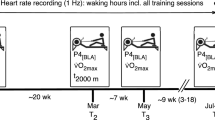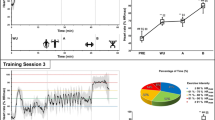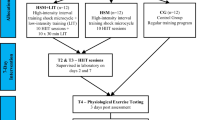Abstract
The purpose of the present study was to evaluate metabolic and mechanical parameters of Spinning® and to verify if the intensities remain within the American College of Sports Medicine recommendations. Fifteen participants (8 males: 39.0±2.0 years; 70.0±2.0 kg; 177.0±2.0 cm, 58.0±3.0 ml/kg/min; and 7 females: 33.6±5.5 years; 56.6±4.4 kg; 165.0±4.6 cm; 48.8±5.5 ml/kg/min) performing an interval Spinning® session had their heart rate (HR), oxygen consumption (VO2) and power output (W) measured. At the beginning and during the Spinning® session, a blood sample was taken for lactate measurements. Statistical difference between phases was performed with ANOVA repeated measure design and a Chi-square test to calculate the frequency of distribution of HRs. The energy cost of the activity was 3367±159 kJ/h (804±38 kcal/h). Participants worked on average at 54% Wmax, 79% VO2max and 86% HRmax. Participants spent 80% of the session above the HR suggested by the instructor. Peak lactate measured was 5.3±0.69 mmol/l. The registered intensity was higher than the guidelines for healthy activities. Therefore Spinning® should be considered a “very intense” activity and particular attention should be paid to novel or unfit participants because no feedback is provided during the session to control the intensity participants are working at.
Similar content being viewed by others
References
ACSM (1998) American College of Sports Medicine position stand on the recommended quantity and quality of exercise for developing and maintaining cardiorespiratory and muscular fitness in healthy adults. Med Sci Sports Exerc 30:975–991
Siscovick DS, Weiss NS, Fletcher RH, Lasky T (1984) The incidence of primary cardiac arrest during vigorous exercise. N Engl J Med 311:874–877
Pollock ML, Wilmore JH (1990) Exercise in health and disease: evaluation and prescription for prevention and rehabilitation, 2nd edn. WB Saunders, Philadelphia, pp 91–160
Martin JE, Dubbert PM (1985) Adherence to exercise. In: Terjung RL (ed) Exercise and sports science reviews, Vol 13. MacMillan, New York, pp 137–167
Pollock ML (1998) Prescribing exercise for fitness and adherence. In: Dishman RK (ed) Exercise adherence: its impact on public health. Human Kinetics Books, Champaign, IL, 259–277
Sallis JF, Haskell WL, Fortman SP et al (1986) Predictors of adoption and maintenance of physical activity in a community sample. Prev Med 15:331–341
Battista RA, Foster C, Andrew J et al (2008) Physiological responses during indoor cycling. J Strength Cond Res 22:1236–1241
Caria MA, Tangianu F, Concu A et al (2007) Quantification of Spinning® bike performance during a standard 50-minute class. J Sports Sci 25:421–429
Kang J, Chaloupka EC, Mastrangelo MA et al (2005) Metabolic and perceptual responses during Spinning® cycle exercise. Med Sci Sports Exerc 37:853–859
Wasserman K, Hansen JE, Sue DY et al (1999) Clinical exercise testing. In: Principles of exercise testing and interpretation, 3rd edn. Lippincott Williams & Wilkins, Philadelphia, pp 130–131
Paton CD, Hopkins WG (2001) Tests of cycling performance. Sports Med 31:489–496
Rudack O, Kilch K, Fromme A et al (2001) Characteristic parameters of physical exercise in indoor cycling as a (typical) fitness 36 sport. In: Proceedings of the 6th Annual Congress of the European College of Sports Science, Cologne, p 1148
Jeukendreup A, Van Diemen A (1998) Heart rate monitoring during training and competition in cyclists. J Sports Sci 16:S91–S99
Montain SJ, Coyle EF (1992) Fluid ingestion during exercise increases skin blood flow independent of increases in blood volume. J Appl Physiol 73:903–910
Author information
Authors and Affiliations
Corresponding author
Rights and permissions
About this article
Cite this article
Piacentini, M.F., Gianfelici, A., Faina, M. et al. Evaluation of intensity during an interval Spinning® session: a field study. Sport Sci Health 5, 29–36 (2009). https://doi.org/10.1007/s11332-009-0073-y
Received:
Accepted:
Published:
Issue Date:
DOI: https://doi.org/10.1007/s11332-009-0073-y




